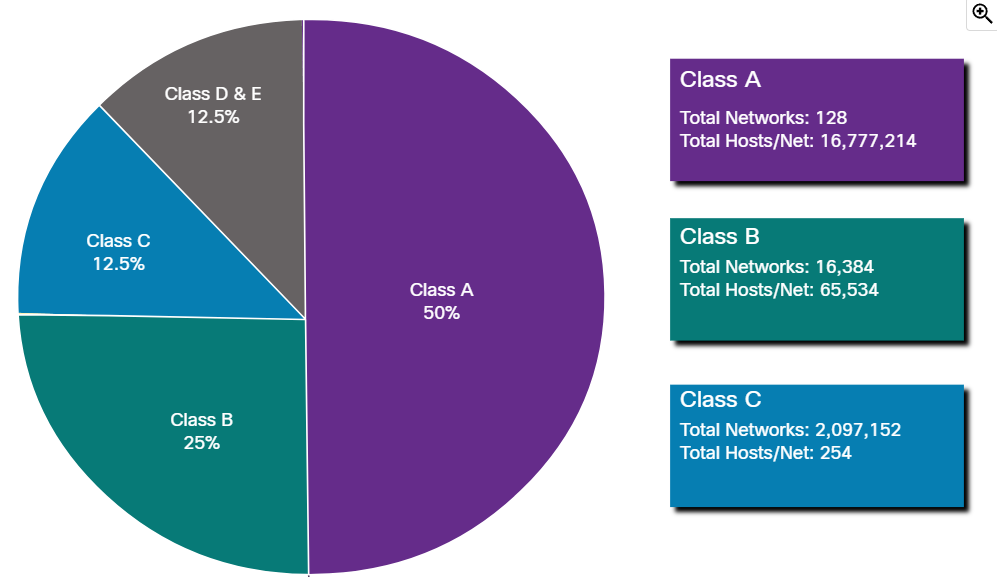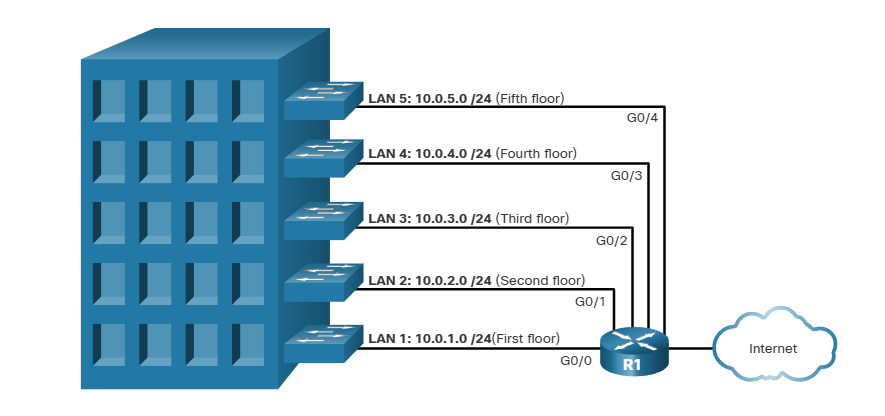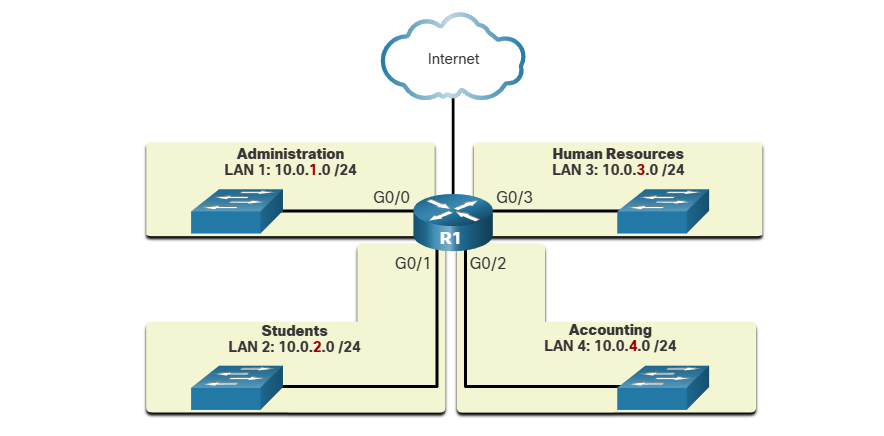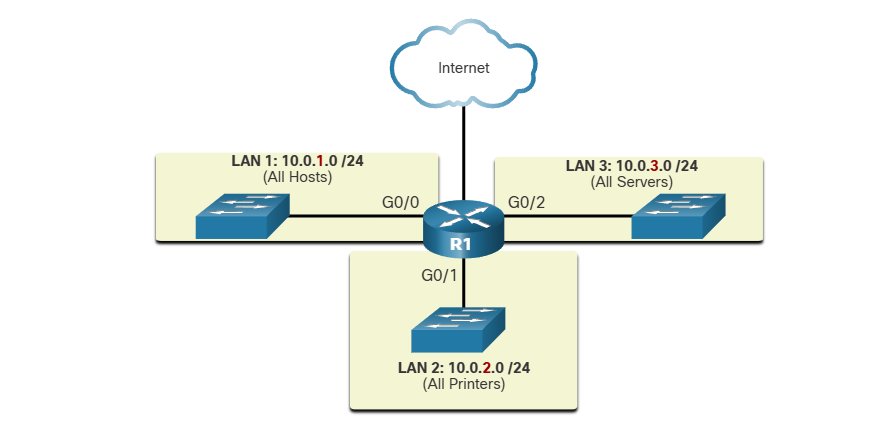9 - IPv4 and Network Segmentation
9.0.2 What will I learn in this module ?
| IPv4 Unicast, Broadcast, and Multicast | Compare the characteristics and uses of the unicast, broadcast and multicast IPv4 addresses. |
| Types of IPv4 addresses | Explainn public, private, and reserved IPv4 addresses. |
| Network segmentation | Explain how subnetting segments a network to enable better communication. |
9.1.2 Unicast
Unicast transmission refers to one device sending a message to one other device in one-to-one communications.
A unicast packet has a destination IP address that is a unicast address which goes to a single recipient. A source IP address can only be a unicast address, because the packet can only originate from a single source. This is regardless of whether the destination IP address is a unicast, broadcast, or multicast.
IPv4 unicast host addresses are in the address range of 1.1.1.1 to 223.255.255.255. However, within this range are many addresses that are reserved for special purposes.
9.1.4 Broadcast
Broadcast transmission refers to a device sending a message to all the devices on a network in one-to-all communications.
A broadcast packet has a destination IP address with all ones (1s) in the host portion, or 32 one (1) bits.
Note: IPv4 uses broadcast packets. However, there are no broadcast packets with IPv6.
A broadcast packet must be processed by all devices in the same broadcast domain. A broadcast domain identifies all hosts on the same network segment. A broadcast may be directed or limited. A directed broadcast is sent to all hosts on a specific network. For example, a host on the 172.16.4.0/24 network sends a packet to 172.16.4.255. A limited broadcast is sent to 255.255.255.255. By default, routers do not forward broadcasts.
Broadcast packets use resources on the network and make every receiving host on the network process the packet. Therefore, broadcast traffic should be limited so that it does not adversely affect the performance of the network or devices
9.1.6 Multicast.
Multicast transmission reduces traffic by allowing a host to send a single packet to a selected set of hosts that subscribe to a multicast group.
A multicast packet is a packet with a destination IP address that is a multicast address. IPv4 has reserved the 224.0.0.0 to 239.255.255.255 addresses as a multicast range.
Hosts that receive particular multicast packets are called multicast clients. The multicast clients use services requested by a client program to subscribe to the multicast group.
Each multicast group is represented by a single IPv4 multicast destination address. When an IPv4 host subscribes to a multicast group, the host processes packets addressed to this multicast address, and packets addressed to its uniquely allocated unicast address.
Routing protocols such as OSPF (Open Shortest Path First) use multicast transmissions. For example, routers enabled with OSPF communicate with each other using the reserved OSPF multicast address 224.0.0.5. Only devices enabled with OSPF will process these packets with 224.0.0.5 as the destination IPv4 address. All other devices will ignore these packets.
9.2 Types of IPv4 Addresses
9.2.1 Public and Private IPv4 Addresses
| Network Address and Prefix | RFC 1918 Private Address Range |
| 10.0.0.0/8 | 10.0.0.0 - 10.255.255.255 |
| 172.16.0.0/12 | 172.16.0.0 - 172.31.255.255 |
| 192.168.0.0/16 | 192.168.0.0 - 192.168.255.255 |
9.2.2 Routing to the Internet
Most internal networks, from large enterprises to home networks, use private IPv4 addresses for addressing all internal devices (intranet) including hosts and routers. However, private addresses are not globally routable.
Private IPv4 Addresses and Network Address Translation (NAT)
Before the ISP can forward this packet, it must translate the source IPv4 address, which is a private address, to a public IPv4 address using Network Address Translation (NAT). NAT is used to translate between private IPv4 and public IPv4 addresses. This is usually done on the router that connects the internal network to the ISP network. Private IPv4 addresses in the organization’s intranet will be translated to public IPv4 addresses before routing to the internet.
9.2.4 Special use IPv4 Addresses
Loopback addresses
Loopback addresses (127.0.0.0 /8 or 127.0.0.1 to 127.255.255.254) are more commonly identified as only 127.0.0.1. These are special addresses used by a host to direct traffic to itself. For example, the ping command is commonly used to test connections to other hosts. But you can also use the ping command to test if the IP configuration on your own device, as shown in the figure.
Link-Local addresses
Link-local addresses (169.254.0.0 /16 or 169.254.0.1 to 169.254.255.254) are more commonly known as the Automatic Private IP Addressing (APIPA) addresses or self-assigned addresses. They are used by a Windows client to self-configure in the event that the client cannot obtain an IP addressing through other methods. Link-local addresses can be used in a peer-to-peer connection but are not commonly used for this purpose.
9.2.5 Legacy Classful Addressing
- Class A (0.0.0.0/8 to 127.0.0.0/8) - Designed to support extremely large networks with more than 16 million host addresses. Class A used a fixed /8 prefix with the first octet to indicate the network address and the remaining three octets for host addresses (more than 16 million host addresses per network).
- Class B (128.0.0.0 /16 - 191.255.0.0 /16) - Designed to support the needs of moderate to large size networks with up to approximately 65,000 host addresses. Class B used a fixed /16 prefix with the two high-order octets to indicate the network address and the remaining two octets for host addresses (more than 65,000 host addresses per network).
- Class C (192.0.0.0 /24 - 223.255.255.0 /24) - Designed to support small networks with a maximum of 254 hosts. Class C used a fixed /24 prefix with the first three octets to indicate the network and the remaining octet for the host addresses (only 254 host addresses per network).
In the mid-1990s, with the introduction of the World Wide Web (WWW), classful addressing was deprecated to more efficiently allocate the limited IPv4 address space. Classful address allocation was replaced with classless addressing, which is used today. Classless addressing ignores the rules of classes (A, B, C). Public IPv4 network addresses (network addresses and subnet masks) are allocated based on the number of addresses that can be justified.
9.2.6 Assignment of IP Addreses
Public IPv4 addresses are addresses which are globally routed over the internet. Public IPv4 addresses must be unique.
Both IPv4 and IPv6 addresses are managed by the Internet Assigned Numbers Authority (IANA). The IANA manages and allocates blocks of IP addresses to the Regional Internet Registries (RIRs). The five RIRs are shown in the figure.
RIRs are responsible for allocating IP addresses to ISPs who provide IPv4 address blocks to organizations and smaller ISPs. Organizations can also get their addresses directly from an RIR (subject to the policies of that RIR).
- AfriNIC (African Network Information Centre) - Africa Region
- APNIC (Asia Pacific Network Information Centre) - Asia/Pacific Region
- ARIN (American Registry for Internet Numbers) - North America Region
- LACNIC (Regional Latin-American and Caribbean IP Address Registry) - Latin America and some Caribbean Islands
- RIPE NCC (Réseaux IP Européens Network Coordination Centre) - Europe, the Middle East, and Central Asia
9.3 Network Segmentation
9.3.2 Broadcast Domains and Segmentation
In an Ethernet LAN, devices use broadcasts and the Address Resolution Protocol (ARP) to locate other devices. ARP sends Layer 2 broadcasts to a known IPv4 address on the local network to discover the associated MAC address. Devices on Ethernet LANs also locate other devices using services. A host typically acquires its IPv4 address configuration using the Dynamic Host Configuration Protocol (DHCP) which sends broadcasts on the local network to locate a DHCP server.
Switches propagate broadcasts out all interfaces except the interface on which it was received. For example, if a switch in the figure were to receive a broadcast, it would forward it to the other switches and other users connected in the network.
9.3.3 Problems with large Broadcast Domains
A large broadcast domain is a network that connects many hosts. A problem with a large broadcast domain is that these hosts can generate excessive broadcasts and negatively affect the network.
The solution is to reduce the size of the network to create smaller broadcast domains in a process called subnetting. These smaller network spaces are called subnets.
LAN 1: 172.10.0.0/16 (400 users)
Could be split
LAN 1: 172.16.0.0/24 (200 users)
LAN 2: 172.16.1.0/24 (200 users)
9.3.4 Reasons for Segmenting Networks
Subnetting reduces overall network traffic and improves network performance. It also enables an administrator to implement security policies such as which subnets are allowed or not allowed to communicate together. Another reason is that it reduces the number of devices affected by abnormal broadcast traffic due to misconfigurations, hardware/software problems, or malicious intent.
Location
Group or Function
Device Type
9.4.1 What did I learn in this Module?
IPv4 Unicast. Broadcast, and Multicast
Unicast transmission refers to one device sending a message to one other device in one-to-one communications. A unicast packet has a destination IP address that is a unicast address which goes to a single recipient. A source IP address can only be a unicast address because the packet can only originate from a single source. This is regardless of whether the destination IP address is a unicast, broadcast or multicast. IPv4 unicast host addresses are in the address range of 1.1.1.1 to 223.255.255.255.
Broadcast transmission refers to a device sending a message to all the devices on a network in one-to-all communications. A broadcast packet has a destination IP address with all ones (1s) in the host portion, or 32 one (1) bits. A broadcast packet must be processed by all devices in the same broadcast domain. A broadcast may be directed or limited. A directed broadcast is sent to all hosts on a specific network. A limited broadcast is sent to 255.255.255.255. By default, routers do not forward broadcasts.
Multicast transmission reduces traffic by allowing a host to send a single packet to a selected set of hosts that subscribe to a multicast group. A multicast packet is a packet with a destination IP address that is a multicast address. IPv4 has reserved the 224.0.0.0 to 239.255.255.255 addresses as a multicast range. Each multicast group is represented by a single IPv4 multicast destination address. When an IPv4 host subscribes to a multicast group, the host processes packets addressed to this multicast address, and packets addressed to its uniquely allocated unicast address.
Types of IPv4 Addresses
Public IPv4 addresses are addresses which are globally routed between ISP routers. However, not all available IPv4 addresses can be used on the internet. There are blocks of addresses called private addresses that are used by most organizations to assign IPv4 addresses to internal hosts. Most internal networks, from large enterprises to home networks, use private IPv4 addresses for addressing all internal devices (intranet) including hosts and routers. However, private addresses are not globally routable. Before the ISP can forward this packet, it must translate the source IPv4 address, which is a private address, to a public IPv4 address using NAT.
Loopback addresses (127.0.0.0 /8 or 127.0.0.1 to 127.255.255.254) are more commonly identified as only 127.0.0.1, these are special addresses used by a host to direct traffic to itself. Link-local addresses (169.254.0.0 /16 or 169.254.0.1 to 169.254.255.254) are more commonly known as the Automatic Private IP Addressing (APIPA) addresses or self-assigned addresses. They are used by a Windows DHCP client to self-configure in the event that there are no DHCP servers available.
In 1981, IPv4 addresses were assigned using classful addressing as defined in RFC 790 (https://tools.ietf.org/html/rfc790), Assigned Numbers. Customers were allocated a network address based on one of three classes, A, B, or C. The RFC divided the unicast ranges into specific classes as follows:
Class A (0.0.0.0/8 to 127.0.0.0/8) - Designed to support extremely large networks with more than 16 million host addresses.
Class B (128.0.0.0 /16 - 191.255.0.0 /16) - Designed to support the needs of moderate to large size networks with up to approximately 65,000 host addresses.
Class C (192.0.0.0 /24 - 223.255.255.0 /24) - Designed to support small networks with a maximum of 254 hosts.
There is also a Class D multicast block consisting of 224.0.0.0 to 239.0.0.0 and a Class E experimental address block consisting of 240.0.0.0 - 255.0.0.0.
Public IPv4 addresses are addresses which are globally routed over the internet. Public IPv4 addresses must be unique. Both IPv4 and IPv6 addresses are managed by the IANA. The IANA manages and allocates blocks of IP addresses to the RIRs. RIRs are responsible for allocating IP addresses to ISPs who provide IPv4 address blocks to organizations and smaller ISPs. Organizations can also get their addresses directly from an RIR.
Network Segmentation
In an Ethernet LAN, devices use broadcasts and ARP to locate other devices. ARP sends Layer 2 broadcasts to a known IPv4 address on the local network to discover the associated MAC address. Devices on Ethernet LANs also locate other devices using services. A host typically acquires its IPv4 address configuration using DHCP which sends broadcasts on the local network to locate a DHCP server. Switches propagate broadcasts out all interfaces except the interface on which it was received.
A large broadcast domain is a network that connects many hosts. A problem with a large broadcast domain is that these hosts can generate excessive broadcasts and negatively affect the network. The solution is to reduce the size of the network to create smaller broadcast domains in a process called subnetting. These smaller network spaces are called subnets. The basis of subnetting is to use host bits to create additional subnets. Subnetting reduces overall network traffic and improves network performance. It helps administrators to implement security policies such as which subnets are allowed or not allowed to communicate together. It reduces the number of devices affected by abnormal broadcast traffic due to misconfigurations, hardware/software problems, or malicious intent.




